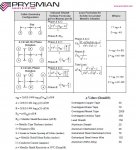Bigjabe
Member
- Location
- Vancouver BC
Hi guys, I know this topic has come up a million times on here, but looking through past posts I didn't really get the answer I need.
This is regarding the bonding of metallic tape shielding of medium voltage cables, and specifically the differences b/w 1/c and 3/c cables.
I understand that in 1/c cables, there is an induced voltage on the shield... if you ground one end it builds up, if you ground both ends you have a current flow.
What I don't understand is what the difference is for 3/c cables - which from what I can tell, have their shields bonded at both ends by default. The shields are still wrapped only around individual conductors, and I don't believe the shields of the 3 conductors are in contact along the length of the cable, and thus I would expect the same induced voltages.
What am I missing here??
This is regarding the bonding of metallic tape shielding of medium voltage cables, and specifically the differences b/w 1/c and 3/c cables.
I understand that in 1/c cables, there is an induced voltage on the shield... if you ground one end it builds up, if you ground both ends you have a current flow.
What I don't understand is what the difference is for 3/c cables - which from what I can tell, have their shields bonded at both ends by default. The shields are still wrapped only around individual conductors, and I don't believe the shields of the 3 conductors are in contact along the length of the cable, and thus I would expect the same induced voltages.
What am I missing here??


